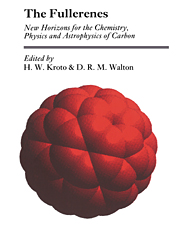Book contents
- Frontmatter
- Contents
- The evolution of the football structure for the C60 molecule: a retrospective
- Dreams in a charcoal fire: predictions about giant fullerenes and graphite nanotubes
- On the formation of the fullerenes
- Production and discovery of fullerites: new forms of crystalline carbon
- Systematics of fullerenes and related clusters
- The fullerenes: powerful carbon-based electron acceptors
- The carbon-bearing material in the outflows from luminous carbon-rich stars
- Elemental carbon as interstellar dust
- The pattern of additions to fullerenes
- Pollyynes and the formation of fullerenes
- Hypothetical graphite structures with negative gaussian curvature
- Fullerenes as an example of basic research in industry
- Deltahedral views of fullerene polymorphism
- Geodesic domes and fullerenes
Systematics of fullerenes and related clusters
Published online by Cambridge University Press: 03 February 2010
- Frontmatter
- Contents
- The evolution of the football structure for the C60 molecule: a retrospective
- Dreams in a charcoal fire: predictions about giant fullerenes and graphite nanotubes
- On the formation of the fullerenes
- Production and discovery of fullerites: new forms of crystalline carbon
- Systematics of fullerenes and related clusters
- The fullerenes: powerful carbon-based electron acceptors
- The carbon-bearing material in the outflows from luminous carbon-rich stars
- Elemental carbon as interstellar dust
- The pattern of additions to fullerenes
- Pollyynes and the formation of fullerenes
- Hypothetical graphite structures with negative gaussian curvature
- Fullerenes as an example of basic research in industry
- Deltahedral views of fullerene polymorphism
- Geodesic domes and fullerenes
Summary
Qualitative theoretical treatments of the fullerene family of molecules can be used to count possible isomers and predict their geometric shapes, point groups, electronic structures, vibrational and NMR spectroscopic signatures. Isomers are generated by the ring-spiral algorithm due to D. E. Manolopoulos. Geometrically based magic number rules devised by the present author account for all electronically closed π shells within the Hückel approximation and these ‘leapfrog’ and ‘cylinder’ rules apply to the wider class of ‘fulleroid’ structures constructed with rings of other sizes. Extrapolations from the theory of carbon clusters are described for doped fullerenes, metallocarbohedrenes, fully substituted boron–nitrogen heterofullerenes and decorated-fullerene models for water clusters.
Introduction
The fullerenes offer a challenge to theoretical chemistry. They are large molecules and, even with modern computational methods, it would be expensive and often uninformative to perform full ab initio calculations on them cage by cage. In the first steps towards understanding these new materials a more qualitative approach is necessary and desirable. Methods based on little more than topology and elementary valence theory can provide information on isomerism, geometric and electronic structure, spectroscopic signatures, stability and selection rules for interconversion. This paper touches on developments in these areas but, in line with the ‘postbuckminsterfullerene’ theme of the meeting, concentrates on new ideas in the theory of exotic fullerenes, heterofullerenes and related heteroatom and molecular clusters.
Fullerenes: isomers and electronic structure
The discovery of C60 (Kroto et al. 1985) carried with it the implication of the existence of a whole series of similar molecules. In the original experiments strong C60 and C70 signals were found in association, and intensity was distributed over a wide range of even-numbered clusters.
Information
- Type
- Chapter
- Information
- The FullerenesNew Horizons for the Chemistry, Physics and Astrophysics of Carbon, pp. 39 - 52Publisher: Cambridge University PressPrint publication year: 1993
Accessibility standard: Unknown
Why this information is here
This section outlines the accessibility features of this content - including support for screen readers, full keyboard navigation and high-contrast display options. This may not be relevant for you.Accessibility Information
- 3
- Cited by
